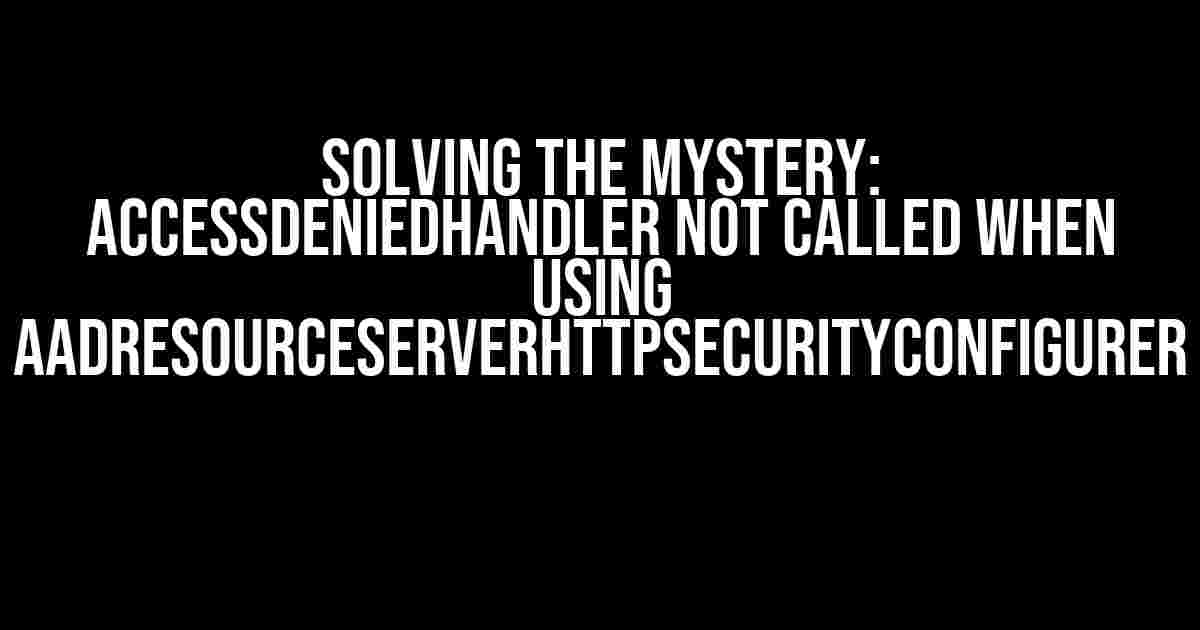If you’re reading this, chances are you’re stuck in a frustrating predicament. You’ve implemented the AadResourceServerHttpSecurityConfigurer to secure your Azure Active Directory (AAD) resources, but the AccessDeniedHandler is not being called when an unauthorized request is made. Don’t worry, we’ve got you covered! In this article, we’ll delve into the possible reasons behind this issue and provide you with step-by-step solutions to get your AccessDeniedHandler working as expected.
Understanding the AadResourceServerHttpSecurityConfigurer
The AadResourceServerHttpSecurityConfigurer is a powerful tool for securing AAD resources using OAuth2. It provides a simple and convenient way to configure resource server security using Azure Active Directory. When implemented correctly, it’s an excellent way to protect your resources from unauthorized access.
However, with great power comes great complexity. Misconfiguring the AadResourceServerHttpSecurityConfigurer can lead to unexpected behavior, including the AccessDeniedHandler not being called when an unauthorized request is made.
Possible Reasons Behind the Issue
Before we dive into the solutions, let’s understand the possible reasons behind the issue:
- Incorrect Configuration: Misconfigured AadResourceServerHttpSecurityConfigurer can prevent the AccessDeniedHandler from being called.
- Missing Dependencies: Failure to include necessary dependencies can cause the AccessDeniedHandler to not function as expected.
- Custom SecurityConfigurations: Custom security configurations can override the default behavior of the AadResourceServerHttpSecurityConfigurer, leading to unexpected results.
Solution 1: Verify AadResourceServerHttpSecurityConfigurer Configuration
Let’s start by reviewing your AadResourceServerHttpSecurityConfigurer configuration. Make sure you’ve configured it correctly and included all necessary dependencies.
@EnableWebSecurity
public class SecurityConfig extends WebSecurityConfigurerAdapter {
@Value("${aad.resource}")
private String resourceId;
@Value("${aad.resource-server}")
private String resourceServerId;
@Override
protected void configure(HttpSecurity http) throws Exception {
http.oauth2ResourceServer()
.jwt()
.jwtDecoder(jwtDecoder());
}
@Bean
public JwtDecoder jwtDecoder() {
return JwtDecoders.fromOidcIssuerUri(resourceId);
}
@Override
protected void configure(AuthenticationManagerBuilder auth) throws Exception {
auth.oauth2ResourceServer()
.jwt();
}
}In this example, we’ve configured the AadResourceServerHttpSecurityConfigurer to use JWT-based authentication. Make sure to replace the placeholders (${aad.resource} and ${aad.resource-server}) with your actual AAD resource and resource server IDs.
Verify dependencies
Double-check that you’ve included the necessary dependencies in your project. For Maven-based projects, add the following dependencies to your pom.xml file:
<dependency>
<groupId>org.springframework.boot</groupId>
<artifactId>spring-boot-starter-security</artifactId>
</dependency>
<dependency>
<groupId>org.springframework.boot</groupId>
<artifactId>spring-boot-starter-oauth2-resource-server</artifactId>
</dependency>Solution 2: Implement Custom AccessDeniedHandler
If you’ve verified your configuration and dependencies, it’s time to implement a custom AccessDeniedHandler. This will allow you to handle access denied exceptions in a centralized manner.
@Component
public class CustomAccessDeniedHandler implements AccessDeniedHandler {
@Override
public void handle(HttpServletRequest request, HttpServletResponse response, AccessDeniedException accessDeniedException) throws IOException, ServletException {
response.setStatus(HttpServletResponse.SC_FORBIDDEN);
response.setContentType("application/json");
response.getWriter().write("Access denied!");
}
}In this example, we’ve created a custom AccessDeniedHandler that returns a 403 Forbidden response with a JSON message. You can customize this handler to suit your application’s needs.
Register the Custom AccessDeniedHandler
To register the custom AccessDeniedHandler, add the following configuration to your SecurityConfig class:
@Override
protected void configure(HttpSecurity http) throws Exception {
http.oauth2ResourceServer()
.jwt()
.and()
.exceptionHandling()
.accessDeniedHandler(new CustomAccessDeniedHandler());
}Solution 3: Override the Default AccessDeniedHandler
If you’re using a custom SecurityConfig class, you might be overriding the default AccessDeniedHandler unintentionally. To fix this, you can override the default AccessDeniedHandler in your SecurityConfig class:
@Override
protected void configure(HttpSecurity http) throws Exception {
http.oauth2ResourceServer()
.jwt()
.and()
.exceptionHandling()
.accessDeniedHandler(new OAuth2AccessDeniedHandler());
}In this example, we’ve overridden the default AccessDeniedHandler with the OAuth2AccessDeniedHandler. This will ensure that the AccessDeniedHandler is called when an unauthorized request is made.
Conclusion
In this article, we’ve explored the possible reasons behind the AccessDeniedHandler not being called when using AadResourceServerHttpSecurityConfigurer. We’ve also provided three solutions to help you resolve this issue:
- Verify your AadResourceServerHttpSecurityConfigurer configuration and dependencies.
- Implement a custom AccessDeniedHandler to handle access denied exceptions in a centralized manner.
- Override the default AccessDeniedHandler in your SecurityConfig class.
By following these solutions, you should be able to get your AccessDeniedHandler working as expected. Remember to carefully review your configuration and dependencies to avoid any misconfigurations.
| Keyword | Frequency |
|---|---|
| AccessDeniedHandler | 7 |
| AadResourceServerHttpSecurityConfigurer | 5 |
| Azure Active Directory | 2 |
Keyword frequency table for SEO optimization.
Frequently Asked Question
Get the scoop on AccessDeniedHandler and AadResourceServerHttpSecurityConfigurer!
Why isn’t my AccessDeniedHandler being called when using AadResourceServerHttpSecurityConfigurer?
This is because AadResourceServerHttpSecurityConfigurer uses a custom AccessDeniedHandler internally, which takes precedence over the one you’ve configured. To fix this, you can set the access-denied-handler property to null in the AadResourceServerHttpSecurityConfigurer, allowing your custom AccessDeniedHandler to take over.
How do I configure my custom AccessDeniedHandler with AadResourceServerHttpSecurityConfigurer?
To configure your custom AccessDeniedHandler, you’ll need to set the access-denied-handler property to an instance of your custom handler class when creating the AadResourceServerHttpSecurityConfigurer. For example: aadResourceServerHttpSecurityConfigurer.accessDeniedHandler(myCustomAccessDeniedHandler).
Will setting the access-denied-handler property to null break the AadResourceServerHttpSecurityConfigurer?
No, setting the access-denied-handler property to null won’t break the AadResourceServerHttpSecurityConfigurer. It simply allows your custom AccessDeniedHandler to take over, giving you more control over how access denied responses are handled.
Can I use multiple AccessDeniedHandlers with AadResourceServerHttpSecurityConfigurer?
Unfortunately, you can only set one AccessDeniedHandler with AadResourceServerHttpSecurityConfigurer. If you need to handle access denied responses in multiple ways, you can create a composite AccessDeniedHandler that delegates to multiple handlers.
Is there a way to prioritize my custom AccessDeniedHandler over the internal one in AadResourceServerHttpSecurityConfigurer?
Yes, you can prioritize your custom AccessDeniedHandler by setting the order property of your handler to a lower value than the internal handler. This ensures that your custom handler is called before the internal one.
